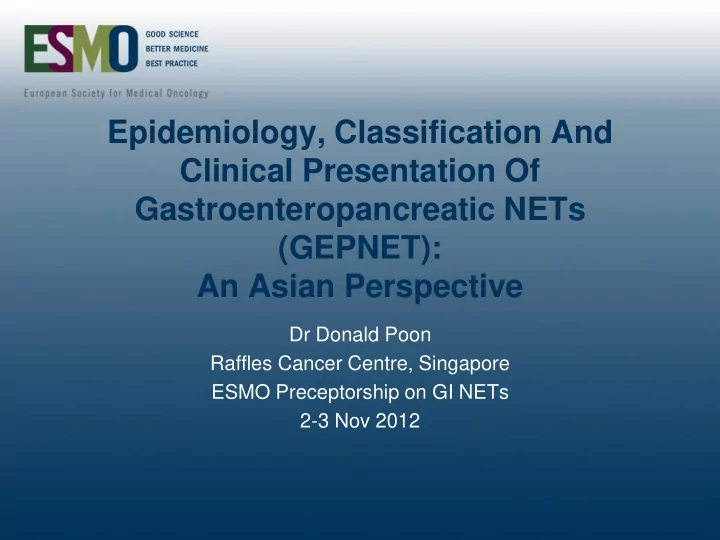

Epidemiology, Classification And Clinical Presentation Of Gastroenteropancreatic NETs (GEPNET): An Asian Perspective Dr Donald Poon Raffles Cancer Centre, Singapore ESMO Preceptorship on GI NETs 2-3 Nov 2012
Background: GEPNET Epidemiology in Asia The Surveillance, Epidemiology, and End Results (SEER) program of the National Cancer Institute provides population based data for the United States of America. Data from the SEER-9 registry indicates that the: Incidence of GEP NET is increasing Primary tumor site varies with age at diagnosis Analyses from the SEER-17 registry indicate that an incremental improvement in survival has occurred over time – from 1973 to 2002, survival improved by 23.1% (p<0.05). To date epidemiological data for GEP NET is lacking in Asia. 11/6/2012 2
The GEPNET Registry: Objectives The GEP NET Registry was established in 2009 to assess: Incidence and prevalence of GEP NET Trends in diagnosis, clinical management and outcome of GEP NET patients Initially started as an Asia-Pacific endeavor but soon included accrual sites outside of Asia-Pacific; centers from Turkey, Israel, Jordan, Lebanon, Saudi Arabia, Egypt, Algeria, and South Africa. 11/6/2012 3
The GEPNET Registry: Method Retrospective data pertaining to the original diagnosis is collected at enrollment: Patient symptoms, tests performed, date of diagnosis, tumor characteristics, initial treatment and response to this treatment. Prospective follow-up data collection occurs every 6 months, at a minimum, and includes: Current treatment and response, changes made to treatment and rationale, methods used to assess treatment efficacy This is a longitudinal, observational study using a web-based data entry portal Patients will be followed for up to 5 years 11/6/2012 4
The GEPNET Registry: Method Inclusion Criteria Adult patients willing to provide informed consent Confirmed diagnosis of GEP NET within 5 years of enrollment Exclusion Criteria Unlikely to be able to obtain long-term follow-up information Simultaneous registration at another participating site Analyses Descriptive analyses have been performed (SAS Version 9.1.3) Missing values have not been imputed The interim analysis data cut off date was 1-Dec-11 11/6/2012 5
The GEPNET Registry: Results - Demographics 621 of 1000 patients have been enrolled as of 1-Dec-11. 608 patients were evaluable. The ethnicity of 252 patients was nominated as Asian. 11/6/2012 6
The GEPNET Registry: Geographical Distribution 11/6/2012 7
The GEPNET Registry: Clinical Presentation At diagnosis, 74% of patients were symptomatic. Having only one dominant symptom was most common. 11/6/2012 8
The GEPNET Registry: Clinical Presentation Most commonly reported symptoms were abdominal pain, weight loss and diarrhea. 11/6/2012 9
The GEPNET Registry: Diagnostic Means A median of 2 (range: 0 – 7) assessment methods were utilized in the diagnosis of GEP NET. The most common methods used were: Pathology review of tissue (97% Asian, 99% non-Asian patients) CT scan (43% Asian, 41% non-Asian patients) Serum CgA testing and octreotide scintigraphy was less commonly used in the diagnosis of Asian vs non-Asian patients (6% vs 12% and 2% vs 10% respectively). Proliferative indices were more frequently included in pathology reports for non-Asian patients. 11/6/2012 10
The GEPNET Registry: Pathology Reporting 11/6/2012 11
The GEPNET Registry: Pathology Reporting 11/6/2012 12
The GEPNET Registry: Pathology Reporting 11/6/2012 13
The GEPNET Registry: Tumor Characteristics The most common primary site is the pancreas In total, 362 (59%) tumors were categorized as non-functional. Of the functional tumors, bowel NET was the dominant type. 11/6/2012 14
The GEPNET Registry: Tumor Characteristics Differences were observed in the distribution of the functional tumor types between Asian and non-Asian patients. 11/6/2012 15
The GEPNET Registry: Treatment Almost all patients (96%) received at least one initial treatment. Surgery was the most common initial treatment (56%), followed by somatostatin analogues (16%) and chemotherapy (16%). Peptide Receptor Radiotherapy (PRRT) is just only available in Singapore. Regular multi-disciplinary NET tumor boards being initiated in Singapore. Regional participation via teleconferencing. 11/6/2012 16
The GEPNET Registry: Conclusion The GEP NET Registry continues to provide important information in relation to the diagnosis and treatment of patients with GEP NET in Asia. This interim analysis of the GEP NET Registry has highlighted the need for clinical practice improvement to ensure the inclusion of proliferative indices in pathology reports, particularly in light of the updated WHO criteria (2010). Differences have been observed in the clinical presentation and management of patients who are Asian compared with those who are non-Asian. 11/6/2012 17
Acknowledgements Collaborators and authors for ACOS 2012 presentation of interim results of Gastroenteropancreatic Neuroendocrine Tumors (GEP NET) Registry: Young-Suk Park, Samsung Medical Center, Seoul, Republic of Korea, Şuayib Yalçın, Medical Faculty, Hacettepe University, Ankara, Turkey Simona Grozinsky-Glasberg, Neuroendocrine Tumor Unit, Endocrinology and Metabolism Service, Department of Medicine, Hadassah-Hebrew University Medical Centre, Jerusalem, Israel Nuri Faruk Aykan, Istanbul Medical Faculty, Istanbul University, Istanbul, Turkey Süheyla Serdengeçti, Cerrahpasa Medical Faculty, Istanbul University, Istanbul, Turkey Sezer Sağlam, Gayrettepe Florence Nightingale, Istanbul, Turkey Yan-Shen Shan, National Cheng Kung University Hospital, Tainan, Taiwan Hüseyin Abalı, Medical Faculty, Adana Baskent University, Adana, Turkey Tsann-Long Hwang, Chang-Gang Memorial Hospital-Lin-Kou, Taoyuan, Taiwan 11/6/2012 18
Acknowledgements Raffles Cancer Centre Novartis Oncology Dr Andrew Tan Dr Manish Taneja CNETS National Cancer Centre Dr Lim Hwee Yong Dr Simon Ong Mr William Claxton Dr Koo Wen Hsin Dr Liau Kui Hin Singapore General Hospital Dr David Ng Dr Anthony Goh Dr Kek Peng Chin Dr Pierce Chow Dr Jacqueline Hwang 11/6/2012 19
Thank you 11/6/2012 20
Recommend
More recommend